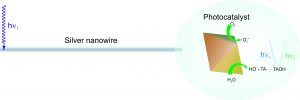Remotely light-controlled activity in dyes, proteins, catalysts: imaging, sensing, energy conversion
A very good visualization – although qualitative at most – of the idea that we put forward in the proposal, is offered by the poem “Switch”, written by the Polish poet, Julian Tuwim. Here is the relevant fragment (translation by David Malcolm):
In the wall there sticks a little switch,
A little switch – electric, which –
Just give that little switch a click –
Brings you light double quick.
It’s easy all right:
Click and there’s light!
Flick once more – then
We’re in darkness again.
And if you give it another go,
You get the glow you had before.
If an electric cable embedded in a wall can be replaced with a very thin but very long metallic nanowire, if the switch becomes a laser that emits photons illuminating one of the nanowire ends, and finally, when a bulb transforms into a photoactive unit, that is such, whose properties depend on this illumination, we can say that the world described in the above poem by Julian Tuwim has been translated into the nanoworld. In this nanoworld, while the mechanisms and processes that emerge between various objects are different to those from our macroworld, some analogies remain.
Within the Project we intend to show that the energy of photons illuminating a nanowire can be transported to its other end, and that this energy is capable to activate and deactivate nanostructures, which are important from the point of view of imaging, sensorics or energy conversion. In fact, there are three types of nanostructures that we intend to remotely switch between various states:
(1) dyes – chemical molecules, which upon illumination with a given wavelength of light can also emit light, but which also when illuminated with a different wavelength will become completely dark again. It seems to be the closest analogy to the electric switch.
(2) protein – nanostructures that contain molecules that emit light, but the energy of this emission can be controlled by the properly chosen excitation wavelength. Depending on this wavelength the protein can emit either yellow or red photons, on demand. We want to show that the color of this emission can be controlled in a remote way by light.
(3) photocatalysts – systems capable of carrying out a chemical reaction upon illumination. Also in this case it is our goal to induce this reaction from a distance, without direct illumination of the photocatalyst by light.
From a slightly different perspective, the research program described in the proposal can be viewed as a combination of an optical fiber and electric cable. Our idea is to put the energy of light into such a cable and by transforming it into electron oscillation, exploit the propagation of energy in a metallic nanowire to initiate and control the state of the object placed at the other end of the nanowire.

